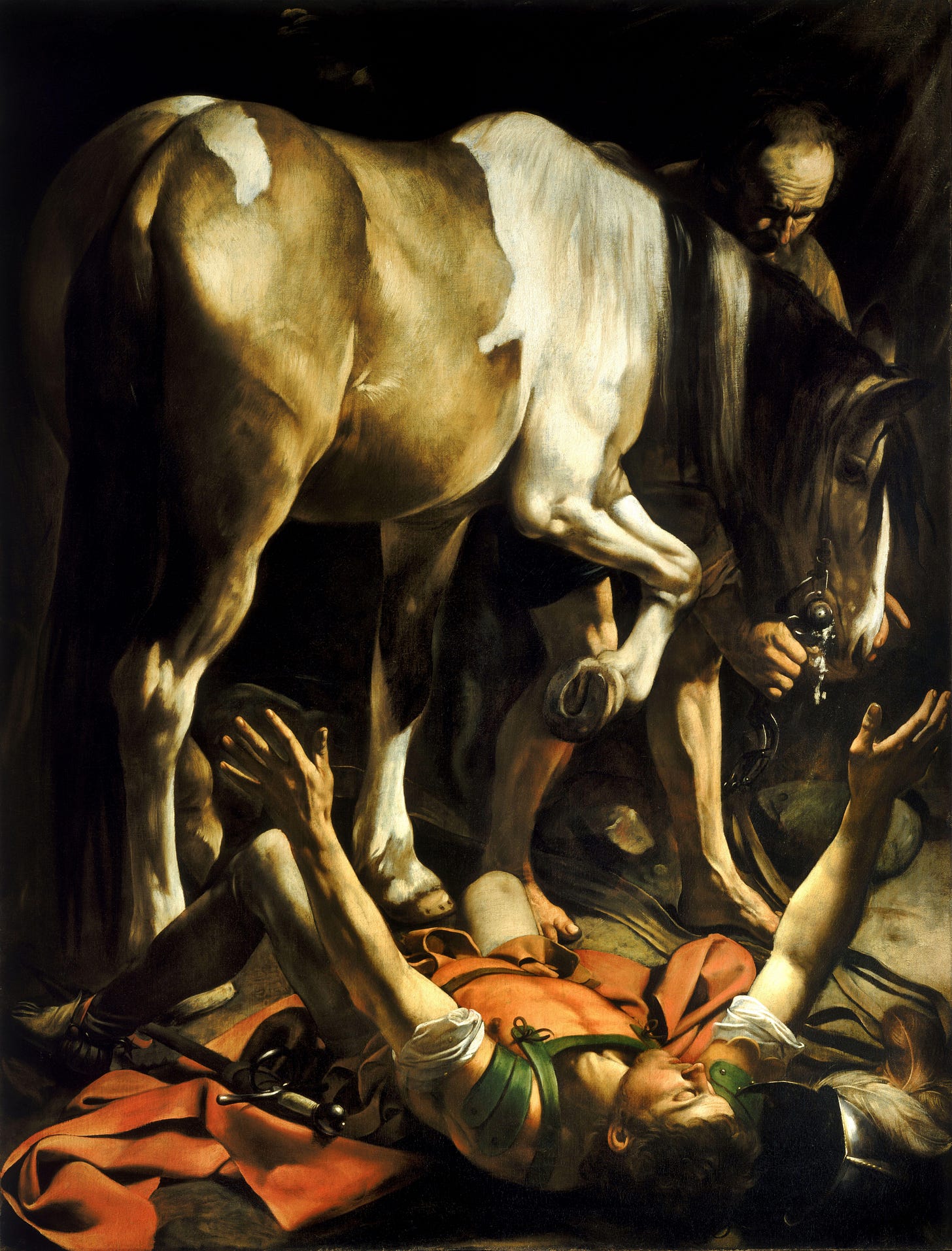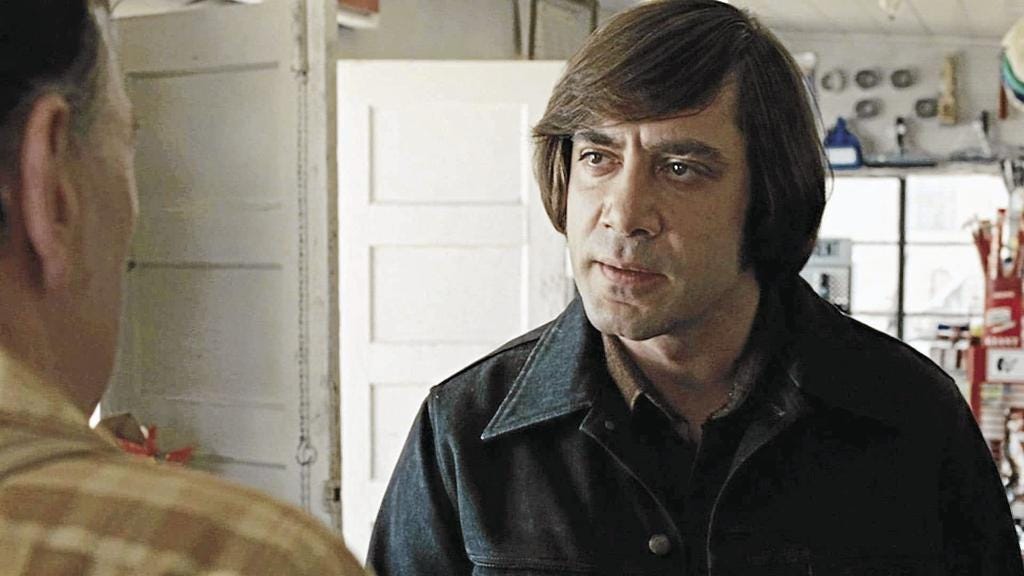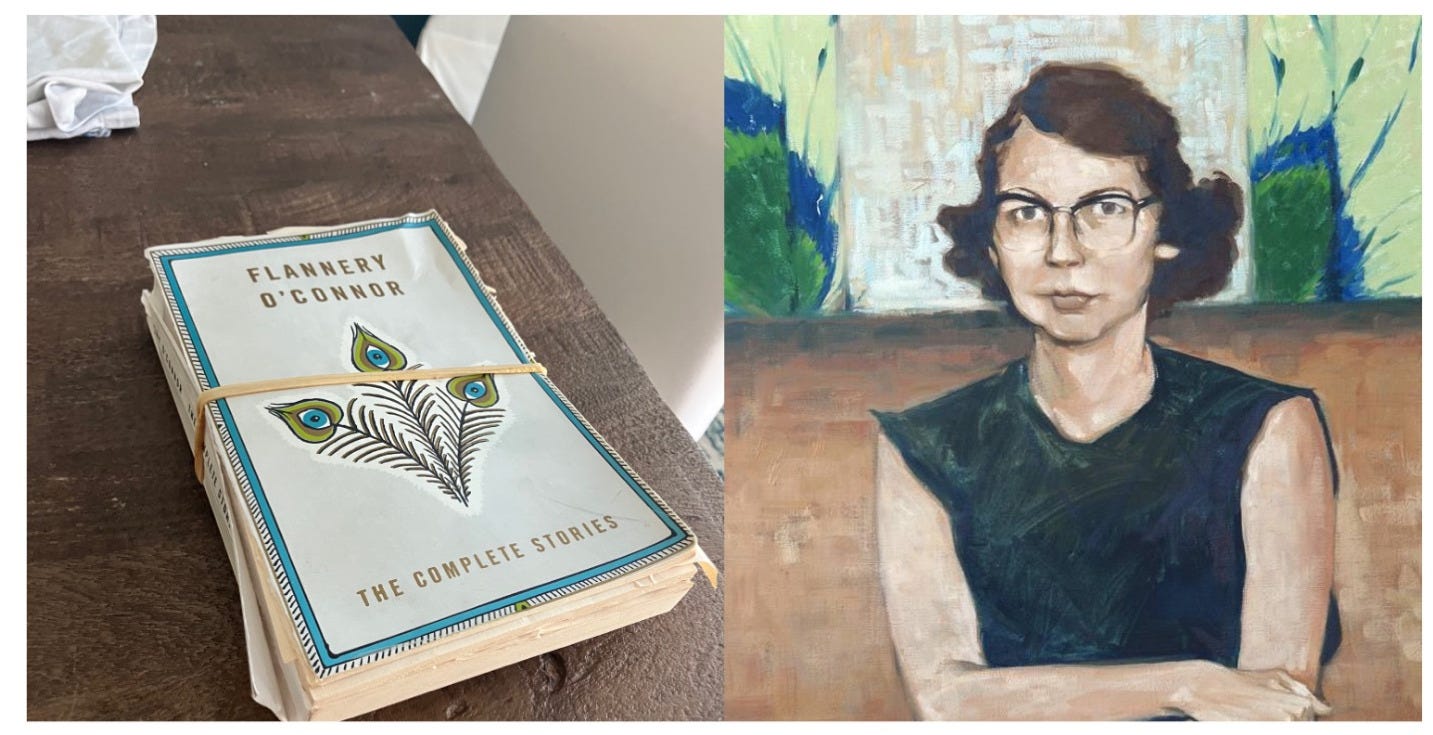This post is part three in a series about Flannery O’Connor. In part one, I suggested reading her literally and looked at the end of “The Life You Save May Be Your Own.” In part two, I walked through how she knocks down prideful characters in “Good Country People” and “Everything That Rises Must Converge.”
Here, I’m going to round out the series with some thought about what might be her ultimate subject: Grace. There’s no skeleton key to reading O’Connor, but judging from her essays, she seemed to feel a disconnect between her vision and her audience. As she says at the end of an essay called “On Her Own Work” in Mystery and Manners:
I have found, in short, from reading my own writing, that my subject in fiction is the action of grace in territory held largely by the devil.
I have also found that what I write is read by an audience which puts little stock either in grace or the devil. You discover your audience at the same time and in the same way that you discover your subject; but it is an added blow.
Whew. Chilly!
If we take her at her word that her subject is “grace,” what is that? In Christianity, grace is the spirit of God poured into you. There’s a whole theology around “sanctifying grace” versus “actual grace,” but the simple version is that it is unearned and freely given as a sort of spiritual help that nudges you away from sin and toward God.
And what is sin? In another essay, “Novelist and Believer,” she explains:
…the greatest dramas naturally involve the salvation or loss of the soul. Where there is no belief in the soul, there is very little drama. The Christian novelist is distinguished from his pagan colleagues by recognizing sin as sin. According to his heritage he sees it not as sickness or an accident of environment, but as a responsible choice of offense against God which involves his eternal future. Either one is serious about salvation or one is not.
And what might she mean by “territory held largely by the devil”? Earlier in the same essay, she described the secular time she was writing in:
We live in an unbelieving age but one which is markedly and lopsidedly spiritual. There is one type of modern man who recognizes spirit within himself but who fails to recognize a being outside himself whom he can adore as Creator and Lord; consequently he has become his own ultimate concern.
In other words, pride. Her subject, as she describes it, is a fallen world in which people have deified themselves (become their own “ultimate concern”) and therefore put their souls at stake by not “recognizing sin as sin.” In her stories, violence has a clarifying effect on her characters, knocking them off the Throne of Me, thereby opening the window for God’s grace.
One theme of this Substack series is what it means to take her at her word as a believer. You might argue her work as an artist transcends her own, possibly limited view of her subject. Maybe. The paradox is that her subject often is the knocking down of pride, and it would certainly be prideful to say my reading of her is more correct than her reading of herself.
I’ve read her both ways — through a secular lens in which her subjects of “grace” and the “devil” are metaphoric in a materialist world, and through a Catholic lens in which she quite plainly believes human life is playing out against the cosmic drama of salvation history. I find the cosmic reading more compelling, but, as the kids say, YMMV (your mileage may vary).
“A Good Man Is Hard to Find”
It’s time to dig into what might be O’Connor’s most famous story. This is the one about the grandmother and the Misfit. When it opens, a family — Dad, Mom, two kids, the Grandmother and the cat — are on a road trip through Georgia, and they hear about an escaped criminal named The Misfit.
The grandmother is somewhat self-centered and oblivious. For example, she’s determined to get her son to take a detour into East Tennessee to see some of her “connections.” Unfortunately, she gets them lost on a little two-lane road. Flustered, she knocks over a valise, startling the cat, which jumps up on Dad and they all end up in a car accident.
While they are surveying the damage, The Misfit and two associates come out of the woods. Still as oblivious as always, the grandmother identifies him — “I recognized you at once!” — likely sealing the family’s fate. He and she have a negotiation about whether he’s a good man, and eventually the associates kill the family, leaving The Misfit and the grandmother for a final confrontation.
After gunshots ring out, she’s in a daze, and they discuss Jesus and whether He raised the dead:
“Listen lady,” he said in a high voice, “if I had of been there I would of known and I wouldn’t be like I am now.” His voice seemed about to crack and the grandmother’s head cleared for an instant. She saw the man’s face twisted close to her own as if he were going to cry and she murmured, “Why you’re one of my babies. You’re one of my own children!” She reached out and touched him on the shoulder. The Misfit sprang back as if a snake had bitten him and shot her three times through the chest.
One of his associates comments that she was a talker, to which The Misfit sums her up: “‘She would have been a good woman,’ The Misfit said, ‘if it had been somebody there to shoot her every minute of her life.’”
There’s enough going on in this story to write a book about, but here maybe we can unpack what this story means in the context of Catholicism, sin, and grace. O’Connor said her subject was “the action of grace in territory held largely by the devil.” I presume critics have speculated about The Misfit representing either the devil (it’s his territory) or possibly Christ (for delivering grace to the grandmother).
For me, the point is the effect on the grandmother. Like Hulga in “Good Country People” or Julian in “Everything That Rises Must Converge,” her selfish (prideful?) mind clears in a moment of violence. If she’d had a gun in her face every moment of her life, she might have had the clarity to understand her soul was on the line and reached out more often in generosity.
Indeed, wouldn’t we all live differently if the stakes of our lives — and our souls — were top of mind in every moment of our lives.
As an aside, I wonder if Cormac McCarthy had The Misfit in mind when he created his Anton Chigurh in No Country for Old Men. Like The Misfit, Chigurh is a philosophical-minded force of evil roaming the countryside, forcing his victims to confront their lives with a cattle prod, the barrel of a gun or a coin toss. “Call it.”
The Artificial What Now?
This is such a great story with such an unfortunate title for our 21st-century sensibilities. I might even go so far as to say that the ending of this story sums up everything she says in her essays about sin and grace and the nature of humanity.
The story is about Mr. Head and his grandson, Nelson, who live in the country. The boy is captivated by the idea of Atlanta, where he was conceived, so one day Mr. Head decides to take him there to try to teach him a lesson about the dangers of the big city. They catch a train into Atlanta and then spend the day roaming around.
Mr. Head wants to appear in charge and worldly, but, addled, he gets them lost. They make their way back toward the train station but take a rest in the afternoon. Mr. Head doesn’t think his grandson has learned the lesson, so he hides, believing that when Nelson wakes up alone, the boy will understand he should be afraid of the city.
The lesson works all too well, because when Nelson wakes up, he panics and knocks over an elderly woman. A group of townspeople circle around Nelson with proverbial pitchforks. Mr. Head shows up, and everyone turns to him expecting him to take charge of the boy and perhaps make some kind of restitution. Although Nelson has clung to him in terror:
Mr. Head sensed the approach of the policeman from behind. He stared straight ahead at the women who were massed in their fury like a solid wall to block his escape. “This is not my boy,” he said. “I never seen him before.”
He felt Nelson’s finger fall out of his flesh.
The women dropped back, staring at him with horror, as if they were so repulsed by a man who would deny his own image and likeness that they could not bear to lay hands on him.
That line — “I never seen him before” — is arguably in the top 10 most brutal lines in American literature. To deny a child like this!
Mr. Head wanders off, trailed by Nelson in the distance. He is deeply aware of his disgrace, and “he lost all hope.” He finally asks for help finding the train station. On the way, the pair of them spot a plaster sculpture of a black man, and as they pause to look at it, grandfather and child reconnect in a way that is both believable but inexplicable.
On the train ride home:
Mr. Head stood very still and felt the action of mercy touch him again but this time he knew that there were no words in the world that could name it. He understood that it grew out of agony, which is not denied to any man and which is given in strange ways to children. He understood it was all a man could carry into death to give his Maker and he suddenly burned with shame that he had so little of it to take with him. He stood appalled, judging himself with the thoroughness of God, while the action of mercy covered his pride like a flame and consumed it. He had never thought himself a great sinner before but he saw now that his true depravity had been hidden from him lest it cause him to despair. He realized that he was forgiven for sins from the beginning of time, when he had conceived in his own heart the sin of Adam, until the present, when he had denied poor Nelson. He saw that no sin was too monstrous for him to claim as his own, and since God loved in proportion as He forgave, he felt ready at that instant to enter Paradise.
That’s a long passage but for me sums up O’Connor’s worldview. Grace, mercy, God’s forgiveness — these are unearned, possibly borne from agony, and the antidote to pride. I say again: Whew.
There’s so much more to say about O’Connor. Plenty of ways to read her work, and plenty of controversy to wade into. But to paraphrase Steve Martin’s character in The Jerk, I gotta go now. What do you think I do, write Substacks all day?







Wow, this is profound stuff and you pulled it off with aplomb. I think you’ve captured a sound approach to her work. Especially that last passage shows how very literal she was in her Biblical/Christian view of things. I mean, these days writers don’t bandy about words like mercy and sin etc. We hide our beliefs and pretend we don’t have them, though we sneak them in!
I was a non-believer when I first read O'Connor years ago (and still am), but was raised in a Christian fundamentalist family and her thematic elements regarding mercy, grace, redemption, and so forth, had a familiar ring. Even though the Catholic kids I knew weren't assaulted quite so vigorously with threats of Hell and damnation. But the drawing of these elements always seemed largely secondary to her highly successful artistry in creating memorable characters and indelible scenes. You've obviously given this subject a good deal of serious thought, and I'm wondering how you'd advise a non-believer without any religious background or particular knowledge beyond the very general to approach these stories. After all, the subjects of grace and mercy and all that are far from simple, although some people make them out to be.